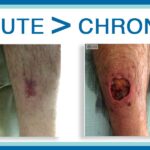Chronic wounds are injuries to the skin or deeper tissues that are not healing in a timely and orderly fashion.
Living beings can heal and repair cells and structures after sustaining injury. From the moment injury occurs, the organism undergoes physiological changes to expedite healing and a return to normal function.
In the human body, a simple cut or scrape will elicit a cascade of events that will deliver increased oxygen and other components that work in unison to repair the skin. Bleeding is the most obvious sign that an acute wound has occurred and is the body’s response to begin the healing process by delivering oxygen, cells to fight infection, and growth factors to enhance new collagen synthesis. New collagen synthesis is especially important, since skin is comprised of collagen.
That stated, sometimes even benign, simple appearing cuts, scrapes or blisters do not proceed to healing as quickly as expected, if at all. There are many reasons delayed healing can occur, with underlying conditions such as diabetes, connective tissue disorders, or circulatory issues often contributing factors. External forces such as pressure overlying a bony prominence, or repetitive shearing on the bottom or side of a foot may also disrupt the healing process.
When should someone be concerned a wound on their body is not healing?
- Regardless of how long a wound has been present, increasing redness, swelling, pain, and fever over 101 degrees are signs of infection and must be treated by a medical professional.
- Persons who may be compromised due to medical conditions or medications (steroids, chemotherapy) can have a delayed or “sub-clinical presentation” – meaning their symptoms may not be obvious despite the presence of a worsening infection.
- Diabetic foot ulcers and skin cancers are often painless, and not obvious due to location, making it difficult for the individual to visualize. Yes, skin cancers can present as open wounds and can be found anywhere on the body.
- In the case of diabetic foot ulcers, not improving by 40% in 4 weeks has been shown to be a standard measure and is a predictor of the ability of a wound to heal. Unfortunately, this measurement is often overlooked until someone has sought treatment in a specialized wound center.
- A prior history of a wound requiring professional treatment puts a person at a greater risk for an acute wound converting into one that is chronic, and the earliest detection of a new wound is reason enough to seek immediate care by a wound specialist.
The take home message is simple: if you have signs of infection, risk factors, or a wound is lingering after several weeks, do not delay seeking treatment. It is not uncommon for the presence of a non-healing wound to be the first indication that there is a far more serious underlying condition that may not have been previously been diagnosed. Bottom line: time is of the essence and the longer one delays obtaining treatment, the greater the chance that more serious issues will ensue, further reducing the ability to heal.


